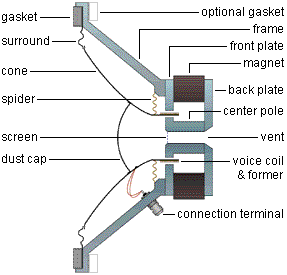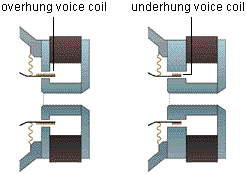woofer

Cutaway view of a typical woofer.
A woofer is the low frequency speaker of a multi-driver loudspeaker system. Sometimes in very low frequency applications it is called a subwoofer. Woofers are generally larger speakers (12–18 inches), but the specific size is not a requirement or the defining feature. Rather the ability to accurately reproduce low frequencies of potentially high amplitude, which tends to require a large throw or excursion (the distance the speaker can move in and out). In any speaker system where multiple drivers are used the woofer is the one for producing the lowest frequencies.
Motor parts of a woofer
Back plate, center pole, front plate
These three parts are usually made of iron or a similar permeable material to form the magnet circuit with the magnet. The front plate and pole piece form the "gap" of the magnet circuit. All three parts, along with the magnet and frame, serve to dissipate heat away from the voice coil. Some drivers (usually small ones such as tweeters and midrange drivers) include ferrofluid in the gap to further cool the voice coil and provide resonance damping.
Magnet
This provides a stationary magnetic field to oppose the alternating electromagnetic field of the voice coil and thereby cause the attached cone to move inward and outward. Most drivers use a ring shaped magnet that is made of a ferrous ceramic material.
Screen, vent
Some drivers include a rear vent to prevent pressure from building behind the cone in the magnet assembly and to provide cooling of the voice coil. A screen is usually provided to prevent debris from entering through the vent.
Voice coil and former
 |
| Woofer voice coils, overhung and underhung |
The voice coil is a coil of wire, usually copper or aluminum, through which the electrical audio signal flows. The flowing current of the audio signal alternates, creating an electromagnetic field which is opposed by the permanent magnetic field of the magnet circuit. This causes the voice coil and diaphragm to move. Some drivers have two (dual) voice coils to provide various wiring options, including the ability of simultaneously connecting two different signals to the driver. Voice coils can be "overhung" or "underhung" as shown in the diagram. An overhung voice coil is taller than the height of the gap, while an underhung voice coil is shorter than the height of the gap. Overhung voice coils are the most common. Underhung voice coils can offer the advantage of a more linear motor strength (BL product) over their excursion range (Xmax) but they are usually more expensive – especially when a large excursion is desired. Finally, the voice coil is wound around the former which serves as a heat-resistant spool for the wire.
Connection terminal
Provides a way to make an electrical connection to the voice coil. A variety of terminal types are used, including simple push-on terminals or gold-plated 5-way binding posts. The positive terminal should be labeled "+" or with a red dot. When the driver is wired so that a positive signal flows to the positive terminal, the cone should move outward. If it moves backward, the terminal labels are reversed. Drivers with dual voice coils will have two sets of terminals.
Diaphragm parts
Cone
Also called the diaphragm, moves like a piston to pump air and create sound waves. The mass of the moving parts (the cone, dust cap, voice coil and former) and the compliance of the suspension (surround and spider) control the resonance (Fs) of the driver which in turn controls its low-frequency response.
Dust cap
Covers the hole in the center of the cone. This has several benefits: it reduces the amount of dust and dirt that can get into the gap of the magnet, it reduces the leakage losses (QL) through the driver, it adds strength to the cone while helping to maintain its shape and it can add mass to the cone to help lower the driver's resonance (Fs). Some dust caps include a screen or vent to allow airflow and aid cooling of the voice coil.
Suspension parts
Spider, surround
These two parts form the suspension of the driver. The suspension fulfills
several purposes: it centers (both axially and front-to-back) the voice
coil in the gap of the magnet circuit and it exerts a restoring force to
keep it there, it limits the maximum mechanical excursion (Xmech) of the
diaphragm and voice coil, it determines the compliance (Cms and Vas) of
the driver and together with the mass of the moving parts determines the
resonance (Fs) of the driver. Ideally, the suspension should provide a linear
restoring force on the diaphragm and voice coil over its full range of excursion.
Frame parts
Frame
Also called the "basket" or "chassis", provides a rigid structure to which the driver components are mounted. It must be made with a high degree of precision so that all of the driver components will align properly. The frame can also aid the motor parts in dissipating heat away from the voice coil. It is commonly made of stamped steel, cast aluminum or plastic.
Gasket, optional gasket
Most drivers include a front gasket to provide a smooth and flat mounting surface. However, since most drivers are mounted using the back side of the mounting flange, a rear (optional) gasket is often desired. The driver should have an airtight seal to the box.


